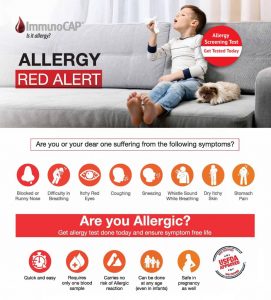Pollen Allergy: Causes and Diagnosis

Pollen allergy, or hay fever, is quite common in India. According to the Ministry of Science and Technology, Government of India, over 20–30% of the Indian population suffers from allergic rhinitis, a result of a pollen allergy, every year. It is an allergic response causing itchy, watery eyes, sneezing, and other similar seasonal allergy symptoms, and if left untreated, it can develop into a severe ailment like asthma.
What is a pollen allergy?
Pollen allergy, or hay fever, is a hypersensitive allergic reaction to pollen grains from trees, grasses, and weeds.
When these tiny particles come in contact with the eyes, skin, or airway, the immune system misidentifies them as harmful antigens, prompting the release of histamines, tryptase, and other chemicals in the body, which lead to the familiar seasonal allergy symptoms.
What causes pollen allergies?
One must have noticed the green dust that settles on the cars come springtime. Well, that is pollen. Spring marks the onset of the growing season for trees and vegetation, which release these pollen grains into the air for reproductive and fertilisation purposes.
But what gets on the car also goes inside the nose and lungs, leading to a stuffy nose, itchy, watery eyes, and uncontrollable sneezing.
Risk factors related to pollen allergy
Several factors might be the reason for the increase in the risk of developing pollen allergies, including:
- Family history: Individuals with a family history of allergies have a higher risk of developing pollen allergies.
- Other allergies: Other types of allergies increase the likelihood of developing pollen allergies.
- Age: Although pollen allergies can develop at any age, they are more common in children and young adults.
- Exposure to pollen: Individuals exposed to high levels of pollen, particularly those living in areas with a high concentration of flowering plants, are at an increased risk of developing pollen allergies.
Symptoms of a pollen allergy
Hay fever symptoms only manifest if a body is in contact with the pollen. Some seasonal allergy symptoms include:
- Nasal congestion and runny nose
- Allergic conjunctivitis is characterised by watery, itchy, and red eyes
- Cough and sneezing
- Itchy nose, throat, and the roof of the mouth
- Postnasal drip is characterized by mucus running down the back of the throat
- Allergic shiners are characterized by swollen bags under the eyes
- Fatigue caused by lack of sleep
How is pollen allergy diagnosed?
Diagnosing pollen allergies primarily involves the Skin Prick Test (SPT) and the Specific IgE Blood Test.
- Skin Prick Test (SPT)
A small drop of the potential allergen is placed on the patient’s skin and then lightly pricked with a needle. If immunoglobulin E (IgE) antibodies toward that allergen are present, the spot will turn red, swell, and itch within 15 to 20 minutes. However, a positive SPT doesn’t confirm an allergy. Doctors compare the test results with the time and place of the symptoms to determine a correlation.
- Specific IgE Blood Test
This test is utilised when skin conditions or certain medications hinder skin testing or in children who might not tolerate skin testing well. In this test, a blood sample is sent to a laboratory where the allergen is added to it. The lab measures the number of antibodies produced to attack the allergens.
Known as Specific IgE (sIgE) Blood Testing, this test provides insight into the immune system’s response to specific allergens. Like with skin testing, a positive blood test doesn’t conclusively indicate an allergy; the results need to be analysed alongside the symptoms and their occurrences.
How to prevent pollen allergy?
Since hay fever arises from a pollen allergy, it has no permanent cure. One can keep them at bay using preventative measures or manage seasonal allergy symptoms using medications prescribed by the doctor.
Prevention is crucial when it comes to pollen allergies. And the best way to do that is to stay informed about daily pollen forecasts. When the pollen count is high, limiting outdoor activities to minimise exposure is advisable. Also, it’s best to keep the windows shuttered to prevent pollen from drifting indoors and further aggravating pollen allergy symptoms. Air conditioning can also come in handy in filtering out pollen and maintaining a comfortable environment. Lastly, since pollen is sticky by nature, it’s important to keep taking a shower and washing the clothes from time to time to remove pollen that might have settled down.
Though pollen allergies are pretty common, seasonal allergy symptoms can disrupt daily activities. It is best to immediately consult the doctor to prevent it from getting worse.
It’s also quite easy to mistake pollen allergies for the common cold. While both have the same symptoms, the treatment differs. The best step would be to conduct a test and be sure that it’s an allergy before you start with the management.
FAQs
How do you stop pollen allergies?
- Stay inside when it’s dry and windy.
- Go out after it rains to avoid pollen.
- Avoid outside work that spreads allergens.
- Change and shower after being outdoors to wash off pollen.
Is pollen allergy genetic?
Allergies are commonly passed down in families. If you’re allergic, chances are high that at least one parent is allergic too.














